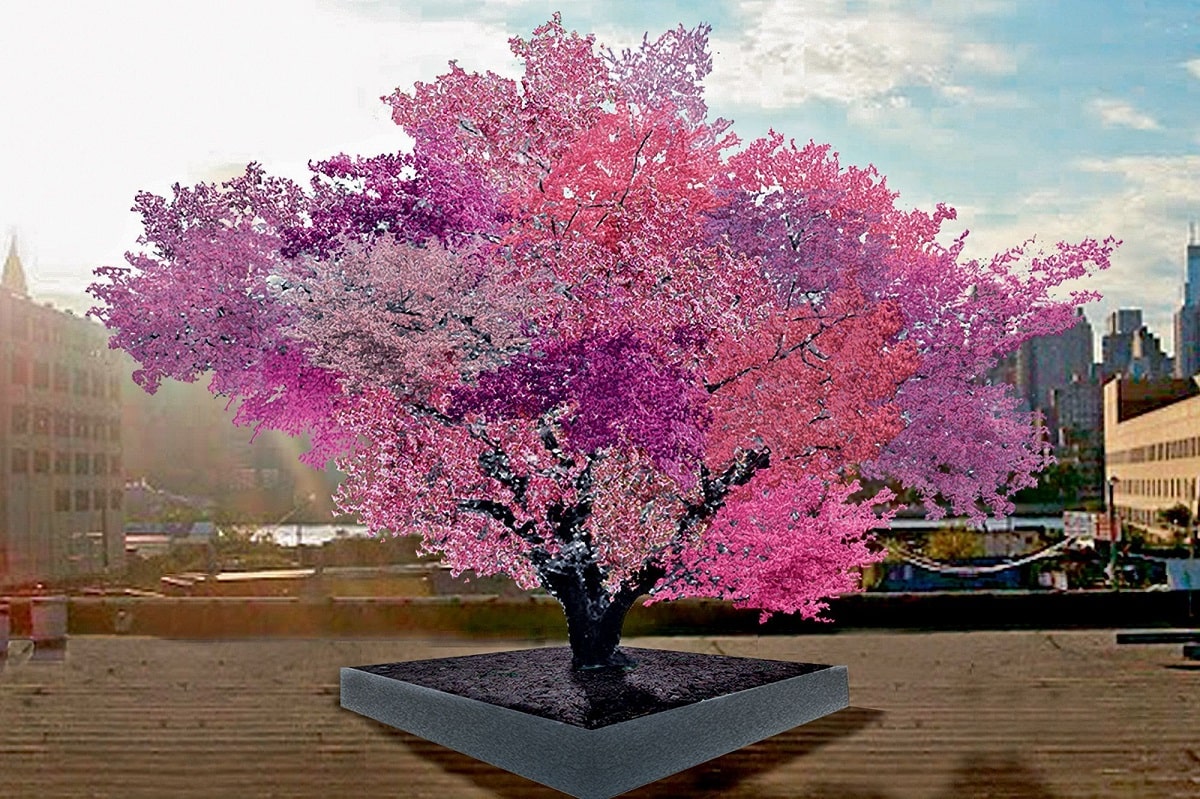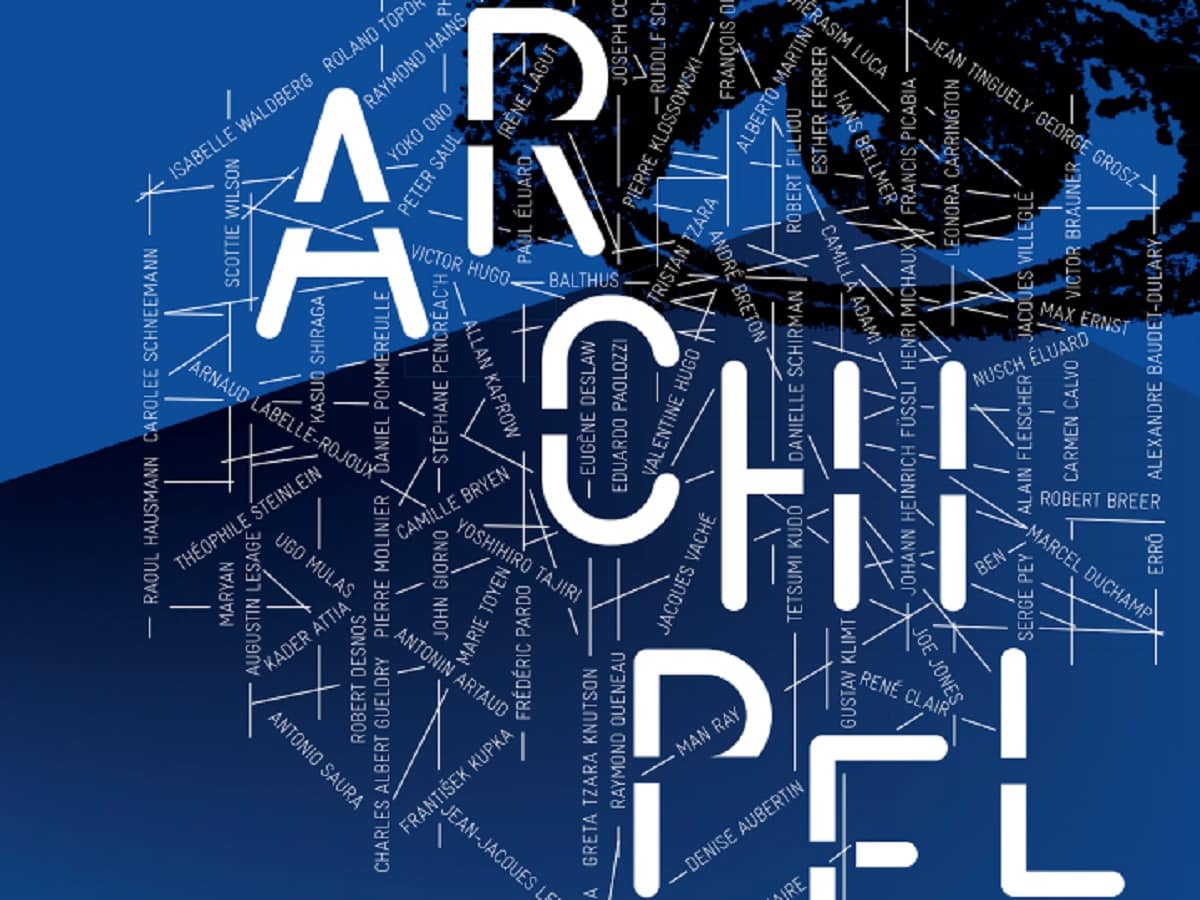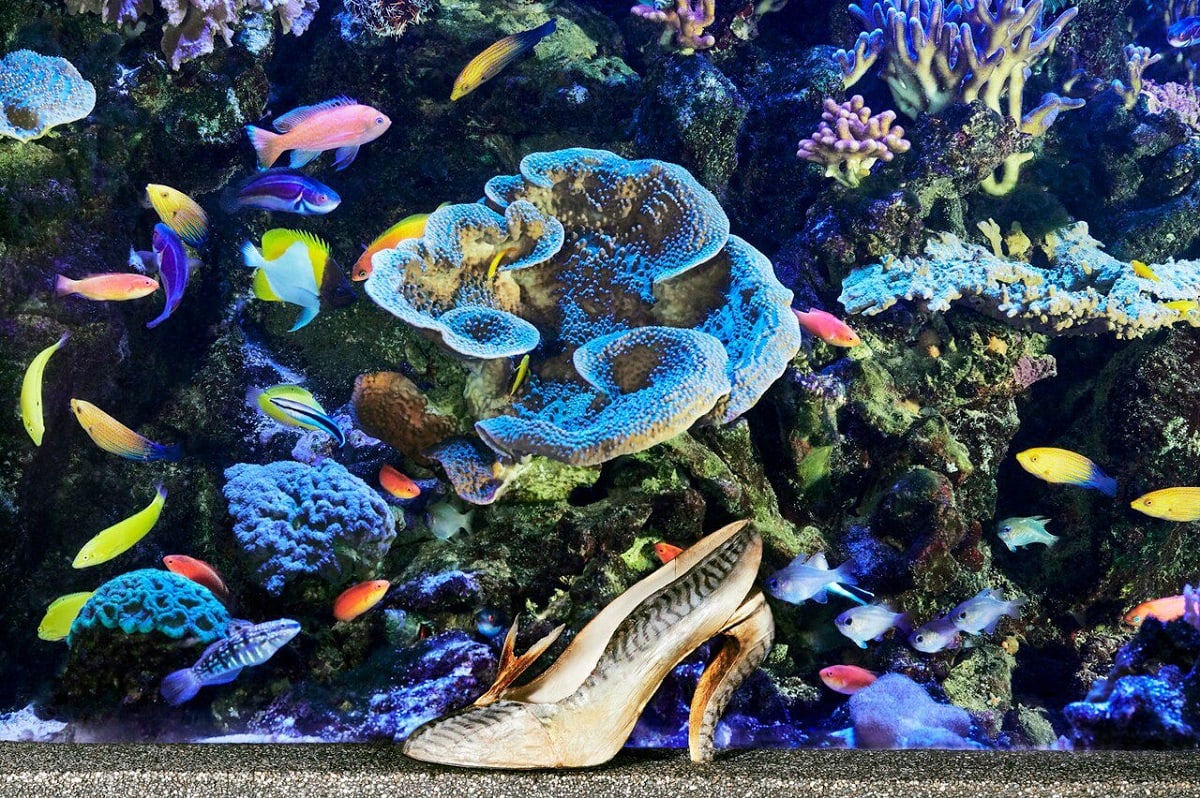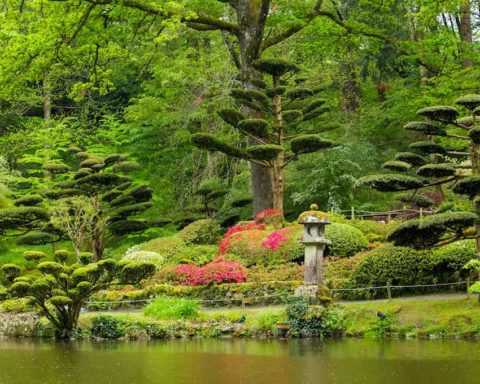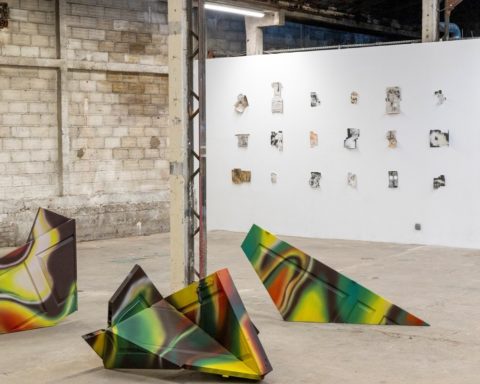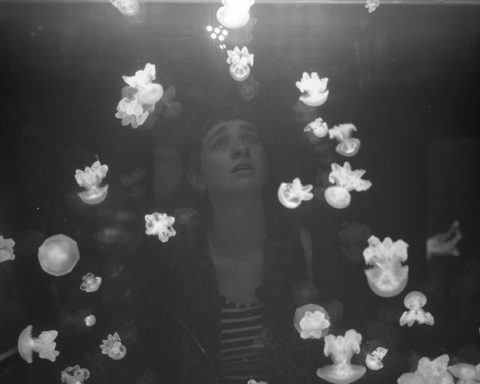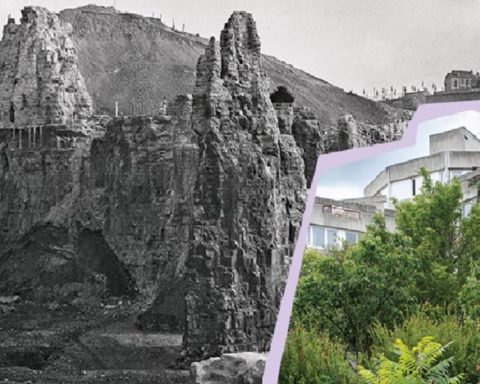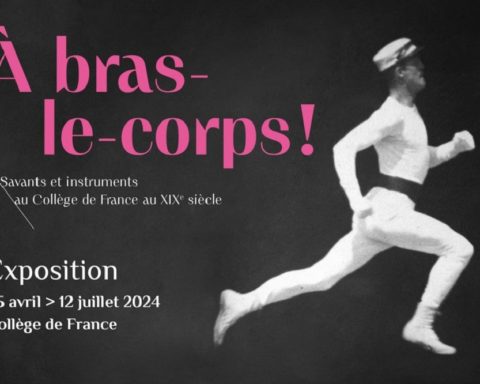From March 17 to July 19, the EDF Group Foundation presents Green Currents, Creating for the Environment. For the first time in France, a major exhibition bringing together international artists committed to the ecological fight.
Joseph Beuys, Barbara and Michael Leisgen, Lucy and Jorge Orta, Sarah Trouche, Nicole Dextras, Jéremy Gobé, Nathan Grimes... all are resolutely committed through their installations, photographs, videos or drawings to confronting the challenges posed by the Anthropocene: a time when human activities are profoundly disrupting natural processes, imposing on humanity new behaviours, a relationship with the environment, a culture and mentalities to be redesigned.
Without pessimism, Green Currents, Create for the Environment underlines with the works presented the process of adaptation that humanity is going through today. The exhibition reminds us that art plays its role in this essential mutation characteristic of the current climate transition by acting on the imagination and proposing new narratives.
Warning, Acting and Dreaming are the three axes that make up the exhibition's journey under the gaze of its curator, Paul Ardenne, art historian and author of the book Ecological Art. Plastic and anthropocene creation (Le Bord de l'Eau, 2018; sec. Augmented Edition, 2019).
Spread over the 400 m² of the EDF Group Foundation area, the exhibition is accompanied by a large educational component inviting visitors to continue the reflection initiated through master classes, conferences and workshops.
Tour of the exhibition
WARNING
With the environmental emergency, one of the artist's first reflexes is to warn. The exhibition shows this position of the artist, that of a sentinel and an alarm caller. To warn, for the artist concerned about environmental issues, is frequently to make an anomaly manifest, as in the case of the large wallpainting type planispheres, variously named Continental Drift or Anthropocene of Christiane Geoffroy (since 2010).
In our eyes, the artist offers the drawing of a map of the world modified in such a way as to expand the areas of our planet where we pollute a lot while at the same time reducing the areas where we pollute little. The distortion of the geographical contours induces another distortion, that of the ecosystem itself. The warning may even go as far as to summon the notion of disappearance - because disrespect for the environment, no less, destroys it and contributes to killing ...
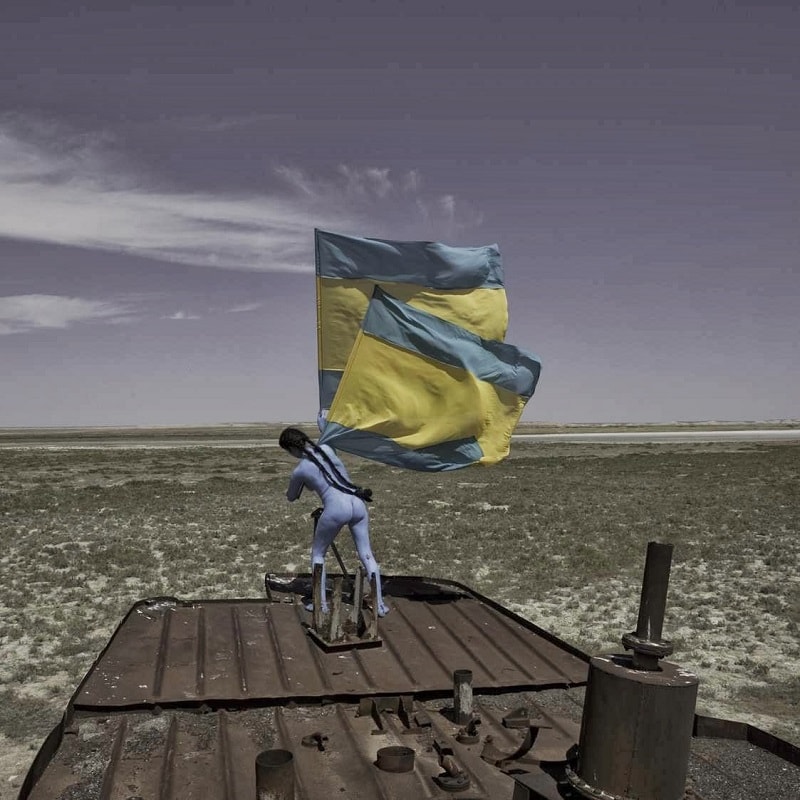
Disappearance of the liquid ecosystem of the Aral Sea with Sarah Trouche who, perched on the carcass of an abandoned fishing boat, struggles with his entire body painted blue (the colour of the water that has disappeared from this area due to over-irrigation of the cotton) against the wind that sweeps across a dry space that has become a desert of rocks, sand and sodium (Aral Survival, 2013).
Disappearance of animals with Ackroyd & Harvey (Stranded, 2006) that transform the corpse of a whale stranded on the coast of the United Kingdom into a stunning bone and jewellery sculpture. How can we fail to read in this work, which mixes natural sciences and art, a tribute to life in its most ultimate manifestation and also desolation or sadness in the face of endangered fauna.
ACT
The impulse to warn leads to action, not to inaction in the face of a situation that has become scandalous or unsustainable. Ecological art, willingly modest in its undertakings, does not aim at the large scale, the upheaval, it willingly acts locally, in constant interaction with scientists, territories, inhabitants, communities.
Thierry BoutonnierThe garden, like a painting, like a sculpture, is a work of art). Its aim is to recover and revive the flora of the Paris region, which has been damaged by urbanisation.
The social dimension of the work of art doubles its ecological dimension. It follows in the footsteps of Joseph Beuys who, in 1982 in Germany, carried out an "action" that was to become legendary by involving the public in a contemporary art event to plant "7,000 thousand oaks" with him.
Jeremy Gobé or Olga Kisseleva also illustrate the local commitment of artists to change the world and the strong link that has existed since the 2010's between art and scientists. These two artists, one French, the other Russian, undertake to save nature with various means, for the first, the coral reef (Corail Artefact), for the second, tree species that have disappeared from the Mediterranean or Oceania (EDEN).
DREAM
Art is not a means of action comparable to the commitment of activists, associations and companies. Asking the "green" artist to be the saviour of a world whose environment is disintegrating before his eyes is necessary and obvious but excessive.
In this section, the artists represented do not have at heart the illusion that the world can be saved with creations born of their imaginations, but the hope that these creations are contagious. What they have in common is a willingness to point in a direction and to encourage virtuous behaviour, giving meaning to this paradigm: "We are not just a group of artists, we are a group of people with a common desire to save the world with creations born of our imagination. We have the art of admitting the possibility of another reality... ".
Remembering that the Bible speaks of the presence in the Garden of Eden of a tree that bears forty different fruits, Sam Van Aken puts all his skill as an artist biologist into recreating this mythological and magically nourishing plant with grafts, cuttings and unnatural shrub combinations - and succeeds in doing so.
Nathan GrimesFrom birch bark, the artist creates music using the discontinuous horizontal striations on the skin of the birch tree as a score.
As for Jacques RougerieAs an architect specialising in marine environments who defines himself as a "pragmatic dreamer", he remembers in his projects for marine cities and exploration vessels that the sea and the ocean are above all producers of energy and resources. Their movements, their currents, their light-filtering capacities, their temperatures and salinity levels, their animal and plant populations... and as such, the vectors of increased autonomy for those who will choose tomorrow to inhabit them wisely and with respect for their environmental offer.
Art makes such proposals possible, proposals that the human future will do what it wants, democratizing them or not, giving them or not a liveable consistency outside the confines of art centres.
Restore, with the help of artists, our intimate link to the living world.
Interview of Lauranne Germont, COAL, by Paul Ardenne
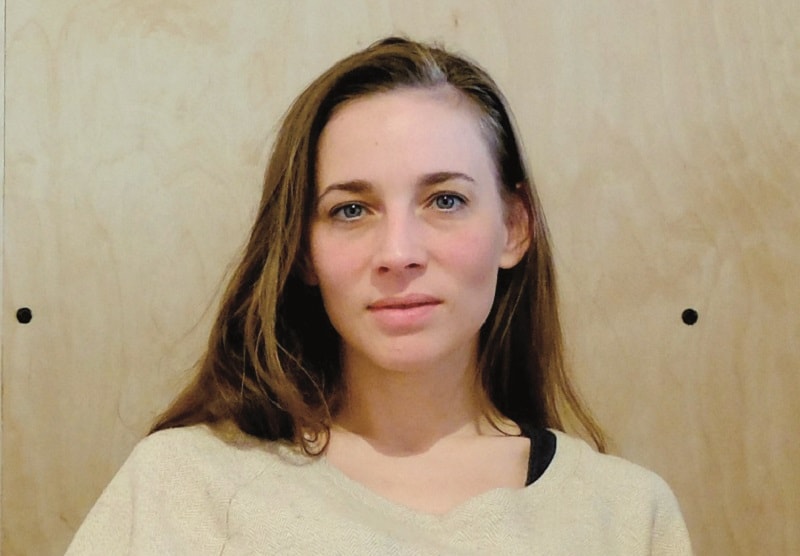
Lauranne Germond art historian and curator, is co-founder of the association COAL which she has directed since its origin in 2008 alongside Loïc Fel and Clément Willemin. Through the COAL Prize, international cooperation actions and more than fifty exhibitions and cultural projects, COAL is the first French actor to promote the emergence of a new culture of ecology.
Paul Ardenne : the notion of "environmental" art is complex. The Anglo-Saxons speak of "Eco Art", which is not necessarily clear either. How would you define, to cut to the shortest possible length, "green" art?
Lauranne Germont : It is always delicate to confine art into categories, especially since this "green" art covers a very great diversity, a vast cloud of green practices! The term "ecological" art has the advantage of covering the political and social field, of referring to the complex and systemic thinking of ecology rather than to its environmental dimension alone, which is quite reductive. One can also challenge the use of the colour green, which tends, for example, to make people forget blue. That of the atmosphere and the oceans, which represent 90 % of the living world...
We must therefore become more precise. A simple definition is excluded?
For my part, I will distinguish three typologies of practices capable of defining what constitutes today a so-called "ecological" art, typologies that often intersect and overlap: witnessing and sharing knowledge; political and symbolic action; and practices of resilience.
Can you elaborate?
First typology: that of artists who bear witness, who give a face to the anthropocene, who make perceptible at the same time the extent of the ecological crisis, the hidden pollution, the distant suffering, the impoverishment of unsuspected resources, the degradation or even destruction of ecosystems and their consequences on populations, living beings and landscapes. This approach covers a wide range of documentary practices but also, more broadly, a large part of current art and science approaches. Each manifestation of the ecological crisis unveils a field of scientific knowledge that fascinates artists and upsets artistic imaginations. Observations, experiments, fieldwork..., the artists appropriate the tools of science to explore, to understand and to share the state of the art in terms of scientific appreciation of the ecological crisis. In return, they shake up the world of straight laboratories and open up perspectives in terms of sharing knowledge and raising awareness of ecology.
A multidirectional creation. Second typology, you said, political and symbolic action.
Yes, the art that acts on the systems at the origin of the ecological crisis to denounce them, to short-circuit them, to transform them. Artistic action, in this case, is more deliberately political. Its weapons are the deprogramming of the imaginary through the writing of new, utopian and dystopian narratives, but also through the decolonization of systems of representation right down to the lexical field. To the point of going so far as to invent new words to enable us to talk about our feelings in contact with climate change, as New York activist artists Heidi Quante and Alicia Escott invite us to do. Let's mention social sculpture again. It reinvests the collective field to give citizens the power to change the rules at microlocal scales (Thierry Boutonnier). Also, the parasitization of legal frameworks (Amy Balkin, Maria Lucia Cruz Correia), with the aim of gaining recognition for environmental rights or crimes through strong symbolic and collective action. This is political ecology in art. It is built on community ties, sharing, conviviality and symbolism.
Which brings us to your third typology, direct activism.
The third field of practice, concerning "green" creation, intends to act directly at the level of ecosystems and the ecological footprint, from a perspective of resilience: art becomes inseparable from the ways of doing and producing. It is based on operating principles such as economy of means, reuse, the use of materials with low environmental impact, the invention of new materials and the restoration of natural environments (Anne Fischer). This may involve bringing nature back to the city or, on the contrary, reactivating the potential of neglected rural areas. There is an explosion of practices in this field. Indeed, we no longer count the third places and the projects of ultralocal territories carried by artists who want to reconcile their convictions, their lifestyles and their creation. Artists then become farmers (Olivier Darné), engineers (Jérémy Gobé), herbalists (Suzanne Husky), shepherds (Fernando Garcia Dory), and even sometimes spiders or wolves (Boris Nordmann).
This art form is de facto closely related to nature. To the point of renewing even the definition of art...
Yes, even if these examples of "naturist" art remind us that this path of reconnection with nature, for our culture which is so far away from it, is not so simple. Ecological art also gives rise to all sorts of attempts to rebuild an intimate link with the living: dialogue with non-human species (interspeciesism), reviving lost states of consciousness through spiritual, ritual or shamanic practices. Here too, a whole field of contemporary art is involved.
Existing in spite of an unsuitable art system
An unquestionable change in the ways of "making art", therefore. How can we explain, however, the relative isolation of these artists?
This isolation is actually quite relative. An art isolated in the art world perhaps but not necessarily isolated in the world at large.
Let's reverse the proposal: wouldn't it be rather the "traditional" art world that finds itself isolated?
I think that the characteristic of ecological art is that it is much more connected to reality and to other spheres of society than conventional contemporary art: inclusive by nature, this art is in constant interaction with scientists, territories, inhabitants, communities, educational institutions, urban planning services and nature conservation actors. There are also a large number of collectives and artists who do not hesitate to share their signature! It is precisely this interconnection and this sense of sharing that makes it so rich and which fascinates me on a daily basis. So I would not describe the ecological artist as isolated! On the other hand yes, he may have difficulties to exist or to be recognized in the established frameworks of contemporary art.
Another problematic aspect is the difficulty of showing this "green" art in the structures of visibility inherited from custom such as art galleries and museums. And what about the market?
Selling works that are most often ephemeral or created in situ is not easy. Can you confirm this?
As we have seen, ecological art practices are diverse. As such and in relation to these practices, there are several stages of diffusion. In terms of showing this creation in traditional places of art, art centres and museums, nothing is always obvious indeed. When one is so involved in field projects, when one favours collaborative processes and approaches to the production of objects, it is sometimes difficult to satisfy both the museum requirement of form and that of ethics and efficiency! Also, we can see that artists will more or less favour one field of expression and dissemination, as they cannot take on all of them. For all that, all ecological artists need institutional recognition in order to continue to act as artists and to be recognized as such. And the good news is that there are more and more new frameworks to show their work and demanding audiences: territorial programs, residencies in very diverse places, transitional urban planning projects, artists run spaces...
As for the art market, if there is a problem, it seems to me that it is not due to the inability of "green" artists to produce works adapted to the desires of the market. Indeed, the market has long been able to integrate immaterial, very minimalist or conceptual works, and to monetize them at a very high price. In fact, the issue of the ecological art market is to a large extent correlated to the ethical and political question. How to make one's convictions cohabit Exist in spite of an ecologically unsuitable art system with the speculative and opaque world of the art market? How can we turn a blind eye to the origin of the great collections, foundations and prizes of contemporary art, very often carried by car manufacturers, financiers, luxury goods manufacturers, the very people who structure and maintain the hyperconsumerist and polluting system that is at issue? A number of ecological art currents, the most militant for sure, have been formed through the contestation of sponsors or patrons of major museums (oil companies, notably with for example the Art But Not Oil coalition). The outrageous declaration of the president of the Friends of the Palais de Tokyo last October against Greta Thunberg, calling for her to be "shot down" (a declaration that rightly foreshadowed her ouster), is symptomatic in this respect: the climate issue remains a subversive subject in the spheres of power! This explains why it is in this field of ecological art that there are the most attempts to develop new frameworks of diffusion and alternative economic models, often based on mutualism and gratuitousness, to gain autonomy from the established frameworks: communities, fablab, double activity...
A valuable mobilization
One essential fact about this "green" art, which loves to celebrate or defend the environment: its effectiveness or not. Does this type of creation hasten the awakening of consciences or does it not sometimes seem to you, in all honesty and without bias, a creation of circumstance, in the air of time, of good conscience?
Its efficiency is both moderate and all-powerful. Subversive art continues to be regularly banned and condemned throughout the world. At the top, we do not underestimate the destabilizing potential of art, its power over the imagination and consciousness, its media effect! No doubt the efficiency of green art is moderate when the artist acts on his own scale, the humble scale of an individual whose processes are never industrialized. This is also what makes it simple and powerful. As a model from which everyone can draw their own power to act. I really like this sentence that an artist said to me, "I feel like the monks of old, outside the chaos and efficiency of the world, I work for others in a way, I take the trouble to do and think for those who don't have the time". There is something of that order in this art, a deeper collective action - magical, symbolic, existential.
So yes, I want to believe that this art is a landmark to move forward, especially when it comes to night. And when we must defend more than ever what we hold dear, the freedom and beauty of the world as we want it to continue to exist.
There is fashion, the "trend" however...
Yes, it is. But I'm not interested in fashion, propriety, good conscience. Are they to be found in this universe? Sometimes yes, certainly, like everywhere else, but it is not in that direction that we should look.
There is, of course, a new generation of cultural foundations with green aspirations whose commitments are sometimes questionable. There are political opportunisms, contradictory practices, but it does not matter, it must in no way overshadow what is true and authentic today, the explosion in the arts, as everywhere else, of this magnificent collective will to repair and rebalance the order of things together. In this respect, the increasingly sustained mobilization of artists can only be valuable.
Curator : Paul ARDENNE
Paul Ardenne is an academic (UFR Arts Amiens), art historian, curator and writer. He is notably the author of the book Un Art écologique, Création plasticienne et anthropocène (La Muette, 2018, 2nd ed. augmentée 2019). He is the author of several exhibitions on environmental issues: Aqua Vitalis - Eau et art contemporain (Caen, 2014), Dendromorphies - Créer avec l'arbre (Paris, 2018), Natura Loci (Gaspésie, Canada, 2018). He is considered an important art historian, in France but also abroad (activity as an international lecturer).
Exhibition " Green Currents - Creating for the Environment". at the EDF Foundation, 6, rue Récamier - 75007 Paris - From March 18 to July 10, 2020

